Categories
Left column house ads
Cooking Like Kurt Gutenbrunner
December 15, 2011 Restaurant/Bar News
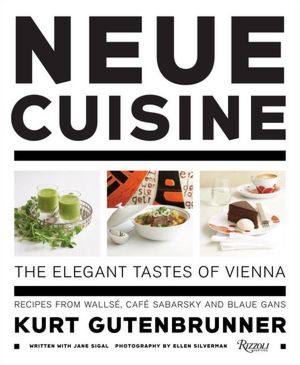 Kurt Gutenbrunner’s new Neue Cuisine belongs in a museum bookshop—it’s that gorgeous. More specifically, it belongs in the bookshop at the Neue Galerie, because it prominently features art and objects from the museum’s collection; if you’re not drooling over the food, you’re drooling over the Klimt paintings, Josef Hoffman silver wine coaster, and so on. But the recipes are not solely from Café Sabarsky, Gutenbrunner’s beloved restaurant at the museum. Patrons of Blaue Gans and Wallsé will recognize such favorites as the chestnut soup, chilled smoked trout crepes (palatschinken), Boston lettuce salad with pumpkin seed oil, and the exquisite soufflé known as the Salzburger Nockerl, not to mention any number of schnitzels and goulashes.
Kurt Gutenbrunner’s new Neue Cuisine belongs in a museum bookshop—it’s that gorgeous. More specifically, it belongs in the bookshop at the Neue Galerie, because it prominently features art and objects from the museum’s collection; if you’re not drooling over the food, you’re drooling over the Klimt paintings, Josef Hoffman silver wine coaster, and so on. But the recipes are not solely from Café Sabarsky, Gutenbrunner’s beloved restaurant at the museum. Patrons of Blaue Gans and Wallsé will recognize such favorites as the chestnut soup, chilled smoked trout crepes (palatschinken), Boston lettuce salad with pumpkin seed oil, and the exquisite soufflé known as the Salzburger Nockerl, not to mention any number of schnitzels and goulashes.
While Gutenbrunner’s introduction, about his journey from a small Danube village named Wallsee to becoming America’s premiere ambassador and interpreter of Austrian food, is engaging, the writing generally doesn’t have the chatty affability of American Flavor, the new cookbook from Locanda Verde‘s Andrew Carmellini (which I cooked from here). Then again, who really expected it to? What it does have is a sumptuousness that makes it an ideal gift.
The Menu
My partner, Adam, and I have different philosophies when it comes to chefs’ cookbooks. He likes to try and replicate the dishes he loves, while I feel that’s doomed to fail. This time around, I won, although the only dish he was obsessing over was the Salzburger Nockerl; if it had been summer, and raspberries were in season, we would’ve gone for it. But we had leftovers from the night before—half a chocolate cake from Tribeca Treats, with seasonally appropriate peppermint ice cream from Whole Foods—so that settled that. For an entrée, I was curious to attempt the monkfish with chanterelles and Jerusalem artichokes, if only because we had never cooked either monkfish or Jerusalem artichokes (a.k.a. sunchokes). By the way, the intro to the recipe says, “You don’t often see monkfish on menus,” which I found sort of flabbergasting; we must not eat at the same places.
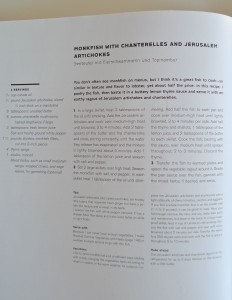
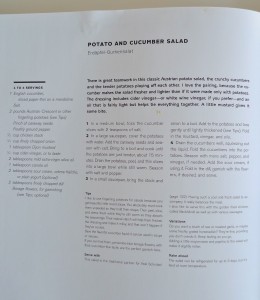 I could swear Adam said he wanted to make the potato salad with cucumbers, although he has no memory of it, and thinks he was actually flagging the recipe on the opposite page, for the potato-kohlrabi gratin. I’m going to have to start taping our conversations, like Nixon. And I added one more recipe—for the Aperol Sour cocktail. I chose it because it gave me an excuse to buy Aperol—I love Campari—and because two of the other five cocktail recipes called for elderflower syrup. I wouldn’t even know where in the supermarket to start looking for such a thing.
I could swear Adam said he wanted to make the potato salad with cucumbers, although he has no memory of it, and thinks he was actually flagging the recipe on the opposite page, for the potato-kohlrabi gratin. I’m going to have to start taping our conversations, like Nixon. And I added one more recipe—for the Aperol Sour cocktail. I chose it because it gave me an excuse to buy Aperol—I love Campari—and because two of the other five cocktail recipes called for elderflower syrup. I wouldn’t even know where in the supermarket to start looking for such a thing.
The morning we were going to cook, after I had already gone to Whole Foods—because I’ll only go before 9 a.m.—Adam asked if we shouldn’t also include a salad, since the meal was looking pretty starchy. So we decided on the fennel and blood orange salad even though we’ve done that kind of thing many times before. Not everything needs to be a challenge.
The Sourcing
I knew this would be a tough meal to source, even without the elderflower syrup. But the fishmonger at the Saturday Tribeca Greenmarket had monkfish (and I made a note to myself to pick up some of the Peconic Bay scallops this week). And not only did Whole Foods have fingerling potatoes, it had the Austrian Crescent variety that Gutenbrunner specifies. And now I know what an English cucumber is! (That’s what she said…?) But the store didn’t have Jerusalem artichokes at all, and the chanterelles were pathetic. I’m grateful for Whole Foods, but when it lets you down, you’re screwed around here.
We went to Noho for lunch, and then we headed our separate ways to do Christmas shopping. Eventually, I passed Citarella, which was no help. And Gourmet Garage was a joke; the guy working there directed me toward the artichokes. So I headed over to Dean & DeLuca, forgetting a cardinal rule of life in New York City: Never, ever, go to Soho on a Saturday in December, let alone Broadway and Prince. But Dean & DeLuca had decent chanterelles ($45 per pound) and Jerusalem artichokes ($9 per pound). And after I had waited in the long checkout line, Adam texted that he went to Whole Foods but they didn’t have any fennel. I have told him a thousand times that you have to ask if you don’t see the produce you want, but he didn’t. We had a talk about that later, long after I had once again braved the line at Dean & Deluca.
Things I skipped: The potato salad recipe called for “borage flowers” as a garnish, which I ignored. And the monkfish recipe suggested chives, marjoram, and sage as a garnish, which would’ve cost me $7.50 total, so I only bought the chives.
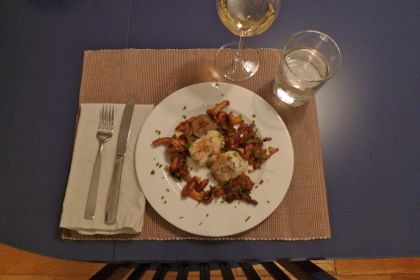 The Cooking
The Cooking
“We don’t have to have the salad,” said Adam after we had enjoyed our Aperol sours. Skipping the salad was a relief from an organizational standpoint, and also because we had cheese with our cocktails. While the potato salad and the monkfish weren’t all that difficult, they weren’t without work. You try peeling two pounds of fingerling potatoes when they’re still hot. (I tend to get the the KP-duty tasks.) There was grumbling when we realized that I didn’t buy skinless monkfish fillets, as Gutenbrunner instructs, but to be fair I’m not sure they skin fish at the Greenmarket. And we had to consult the Internet as to whether one should peel Jerusalem artichokes. Not necessary, I’m happy to report.
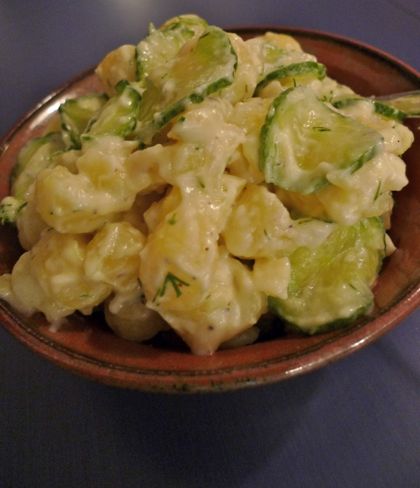 Often, beautiful cookbooks aren’t so helpful, but Neue Cuisine‘s recipes come annotated with tips, variations, serving suggestions, and information on what can be done ahead of time. That said, the monkfish recipe has a lapse; step #2 mentions “Add half the thyme and shallots,” but the other half of the thyme and shallots never gets mentioned. It’s a little thing, and I’m not sure anyone who couldn’t guess what to do with the other half would be cooking from this book in the first place, but it adds stress at a point when you don’t need it.
Often, beautiful cookbooks aren’t so helpful, but Neue Cuisine‘s recipes come annotated with tips, variations, serving suggestions, and information on what can be done ahead of time. That said, the monkfish recipe has a lapse; step #2 mentions “Add half the thyme and shallots,” but the other half of the thyme and shallots never gets mentioned. It’s a little thing, and I’m not sure anyone who couldn’t guess what to do with the other half would be cooking from this book in the first place, but it adds stress at a point when you don’t need it.
The Bottom Line
The Aperol sours were tasty enough, although I misread the recipe and served them with seltzer, turning them into even more of a summer drink. I think I’m more of a Campari person than an Aperol one, but this might be one of those times when there aren’t two kinds of people in the world. And/or I’d generally just be happy with a gin and tonic, but who wants to read about that? The monkfish was delicious, although more garnish would’ve prettied up the plate and tempered the richness—because Jerusalem artichokes, it turns out, absorb the oil and butter they’re cooked in. That’s not a complaint! Jerusalem artichokes will enter our repertory—they’re nutty and wonderful—as long as I don’t have to go Dean & DeLuca to find them. As for the potato salad, I loved it when I tasted it mid-preparation, and I loved it just a little less after I added the sour cream. Gutenbrunner says it’s optional, but we tend to add fat whenever possible. The result was that the tang got diluted, which was a pity. The cukes, sliced thin with a mandoline, added color and crunch; we’ll be using English cucumbers in the future, if only for the scalloped edges. All in all, I’d definitely make the potato salad again, probably in summer, and absolutely if someone could teach me a trick for peeling hot little potatoes.
A Few Last Thoughts
• Food photography is tough and I’m no expert, but it’s really hard when you’re also trying to cook.
• When attempting to cook more than one recipe from the same book simultaneously, make a copy of the recipes so you don’t have to flip back and forth.
• You can buy it online or at Barnes & Noble, and I’m sure Blaue Gans is selling it. The retail price is $45.
4 Comments
Subscribe
Subscribe to the TC Newsletter








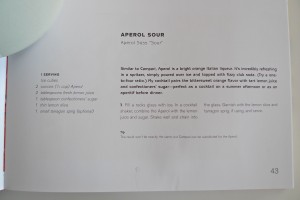
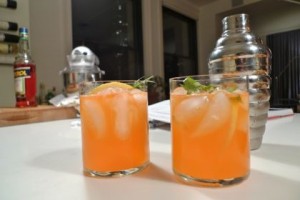










Thanks for giving me the opportunity to vicariously enjoy this lovely meal and not have to clean up the kitchen.
There’s a place at the Union Square farmer’s market on Saturdays that usually has Jerusalem artichokes: west side of the square on the outside, opposite about 15th street, red and yellow tent, lots of root veg, including an amazing selection of potatoes. Don’t remember the price but I doubt if they’re anywhere near $9/lb. Just eat them raw like carrots.
Ikea has elderflower drink concentrate (don’t know if that’s the same thing) in their little grocery section. And you get to ride the ferry. My own recipe: add a tablespoon or two to a liter of seltzer for a non-icky-sweet soda. That’s about as much cooking as I can manage.
I would try Amish Market or Bell Bates for the Elderflower syrup.
My trick for peeling hot little potatos – don’t! The skin is tender, you get added fibre and vitamins and the difference in texture would be minimal.
Also, skinning raw monkfish makes me not want to eat it anymore. Try taking the skin off after its cooked (if the recipe allows).
And, keep the cooking adventure posts coming. They’re entertaining and inspiring. ‘Pioneer Woman’ offers some food photography tips and she’s come a long way.
@Andrea: I wonder if Pioneer Woman’s partner is sitting at the table asking when the hell she’s going to sit down and eat?
Not everyone is as civilized as you and I. I think they do a lot of their eating standing up around there.
And, just like around here, I think he’s happy someone else is doing the cooking.